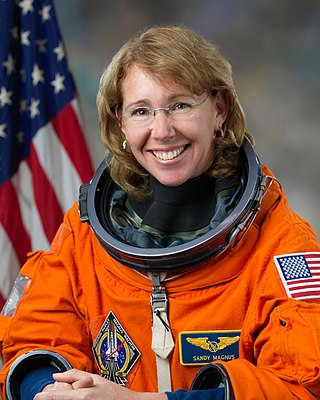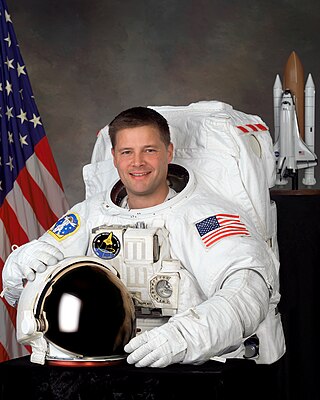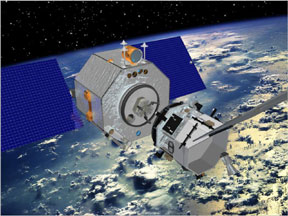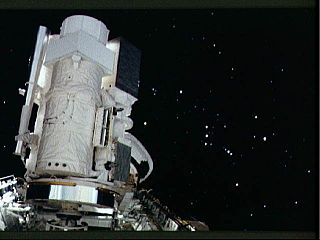Related Research Articles

Spacelab was a reusable laboratory developed by European Space Agency (ESA) and used on certain spaceflights flown by the Space Shuttle. The laboratory comprised multiple components, including a pressurized module, an unpressurized carrier, and other related hardware housed in the Shuttle's cargo bay. The components were arranged in various configurations to meet the needs of each spaceflight.

Convair, previously Consolidated Vultee, was an American aircraft-manufacturing company that later expanded into rockets and spacecraft. The company was formed in 1943 by the merger of Consolidated Aircraft and Vultee Aircraft. In 1953, it was purchased by General Dynamics, and operated as their Convair Division for most of its corporate history.

Sandra Hall Magnus is an American engineer and a former NASA astronaut. She returned to Earth with the crew of STS-119 Discovery on March 28, 2009, after having spent 134 days in orbit. She was assigned to the crew of STS-135, the final mission of the Space Shuttle. She is also a licensed amateur radio operator with the call sign KE5FYE. From 2012 until 2018 Magnus was the executive director of the American Institute of Aeronautics and Astronautics.

STS-67 was a human spaceflight mission using Space ShuttleEndeavour that launched from Kennedy Space Center, Florida on 2 March 1995.

Jeffrey Alan Hoffman is an American former NASA astronaut and currently a professor of aeronautics and astronautics at MIT.

The Lockheed Martin X-33 was a proposed uncrewed, sub-scale technology demonstrator suborbital spaceplane that was developed for a period in the 1990s. The X-33 was a technology demonstrator for the VentureStar orbital spaceplane, which was planned to be a next-generation, commercially operated reusable launch vehicle. The X-33 would flight-test a range of technologies that NASA believed it needed for single-stage-to-orbit reusable launch vehicles, such as metallic thermal protection systems, composite cryogenic fuel tanks for liquid hydrogen, the aerospike engine, autonomous (uncrewed) flight control, rapid flight turn-around times through streamlined operations, and its lifting body aerodynamics.

Ronald Anthony Parise was an Italian American scientist who flew aboard two NASA Space Shuttle missions as a payload specialist.
The Microvariability and Oscillations of Stars/Microvariabilité et Oscillations STellaire (MOST), was Canada's first space telescope. Up until nearly 10 years after its launch it was also the smallest space telescope in orbit. MOST was the first spacecraft dedicated to the study of asteroseismology, subsequently followed by the now-completed CoRoT and Kepler missions. It was also the first Canadian science satellite launched since ISIS II, 32 years previously.
The Multi-Unit Space Transport And Recovery Device or MUSTARD, usually written as Mustard, was a reusable launch system concept that was explored by the British Aircraft Corporation (BAC) during the mid-1960s.

Buzz Lightyear's Space Ranger Spin is an interactive shooting dark ride attraction located in the Tomorrowland area of the Disney theme parks. Designed by Walt Disney Imagineering, this attraction combines a carnival game and a third-generation Omnimover system. It is inspired by Disney/Pixar's Toy Story franchise, and contains several elements loosely based on the cartoon series Buzz Lightyear of Star Command.
Lockheed Martin Space is one of the four major business divisions of Lockheed Martin. It has its headquarters in Littleton, Colorado, with additional sites in Valley Forge, Pennsylvania; Sunnyvale, California; Santa Cruz, California; Huntsville, Alabama; and elsewhere in the United States and United Kingdom. The division currently employs about 16,000 people, and its most notable products are commercial and military satellites, space probes, missile defense systems, NASA's Orion spacecraft, and the Space Shuttle external tank.

Suzaku was an X-ray astronomy satellite developed jointly by the Institute of Space and Aeronautical Science at JAXA and NASA's Goddard Space Flight Center to probe high energy X-ray sources, such as supernova explosions, black holes and galactic clusters. It was launched on 10 July 2005 aboard the M-V launch vehicle on the M-V-6 mission. After its successful launch, the satellite was renamed Suzaku after the mythical Vermilion bird of the South.

The National Aeronautics and Space Administration (NASA) insignia has three main official designs, although the one with stylized red curved text was retired from official use from May 22, 1992, until April 3, 2020, when it was reinstated as a secondary logo. The three logos include the NASA insignia, the NASA logotype, and the NASA seal.

Douglas Harry "Wheels" Wheelock is an American engineer and astronaut. He has flown in space twice, logging 178 days on the Space Shuttle, International Space Station, and Russian Soyuz. On July 12, 2011, Wheelock announced that he would be returning to active duty with the United States Army in support of Operation Enduring Freedom. He is currently working with NASA to test the Orion spacecraft at the Glenn Research Center in Plum Brook, Ohio.

Orbital Express was a space mission managed by the United States Defense Advanced Research Projects Agency (DARPA) and a team led by engineers at NASA's Marshall Space Flight Center (MSFC). The Orbital Express program was aimed at developing "a safe and cost-effective approach to autonomously service satellites in orbit". The system consisted of two spacecraft: the ASTRO servicing satellite, and a prototype modular next-generation serviceable satellite; NEXTSat. The mission launched from Cape Canaveral Air Force Station on 8 March 2007, aboard an Atlas V expendable launch vehicle. The launch was part of the United States Air Force Space Test Program STP-1 mission.

Astrosat is India's first dedicated multi-wavelength space telescope. It was launched on a PSLV-XL on 28 September 2015. With the success of this satellite, ISRO has proposed launching AstroSat-2 as a successor for Astrosat.

Hitomi, also known as ASTRO-H and New X-ray Telescope (NeXT), was an X-ray astronomy satellite commissioned by the Japan Aerospace Exploration Agency (JAXA) for studying extremely energetic processes in the Universe. The space observatory was designed to extend the research conducted by the Advanced Satellite for Cosmology and Astrophysics (ASCA) by investigating the hard X-ray band above 10 keV. The satellite was originally called New X-ray Telescope; at the time of launch it was called ASTRO-H. After it was placed in orbit and its solar panels deployed, it was renamed Hitomi. The spacecraft was launched on 17 February 2016 and contact was lost on 26 March 2016, due to multiple incidents with the attitude control system leading to an uncontrolled spin rate and breakup of structurally weak elements.

Orbit is the name given to Major League Baseball's Houston Astros mascot, a lime-green alien wearing an Astros jersey with antennae extending into baseballs. Orbit was the team's official mascot from the 1990 through the 1999 seasons until the 2000 season, where Junction Jack was introduced as the team's mascot with the move from the Astrodome to then Enron Field. Orbit returned on November 2, 2012, at the unveiling of the Astros new look for their 2013 debut in the American League. The name Orbit pays homage to Houston's association with NASA and nickname Space City.

The Hopkins Ultraviolet Telescope (HUT) was a space telescope designed to make spectroscopic observations in the far-ultraviolet region of the electromagnetic spectrum. It was flown into orbit on the Space Shuttle and operated from the Shuttle's payload bay on two occasions: in December 1990, as part of Shuttle mission STS-35, and in March 1995, as part of mission STS-67.
The Lockheed Star Clipper was a proposed Earth-to-orbit spaceplane based on a large lifting body spacecraft and a wrap-around drop tank. Originally proposed during a United States Air Force program in 1966, the basic Star Clipper concept lived on during the early years of the NASA Space Shuttle program, and as that project evolved, in a variety of new versions like the LS-200.